|
Timeline
1971
Chainmail Magazine
1974
Dungeons & Dragons
Orginal version
1977
Dungeons & Dragons
2nd version
2nd version was the branching
point between D&d and AD&D
1981
Dungeons & Dragons
3rd version
1983
Dungeons & Dragons
4th version
1991
Dungeons & Dragons
5th version
3rd edition was result of the
merging with the discontinued
Advanced Dungeons & Dragons
branch
2000
Dungeons & Dragons
3rd Edition (Technically 6th version)
2003
Dungeons & Dragons Revised 3rd Edition
(version 3.5)
2008 - 2010
Dungeons & Dragons
4th Edition |
Brief History of Dungeons & Dragons

Dungeons & Dragons (abbreviated as D&D or DnD) is a fantasyrole-playing game (RPG) originally designed by Gary Gygax and Dave Arneson, and first published in 1974 by Tactical Studies Rules, Inc. (TSR). The game has been published by Wizards of the Coast since 1997. It was derived from miniature wargames with a variation of the Chainmail game serving as the initial rule system. D&D's publication is widely regarded as the beginning of modern role-playing games and the role-playing game industry.
D&D departs from traditional wargaming and assigns each player a specific character to play instead of a military formation. These characters embark upon imaginary adventures within a fantasy setting. A Dungeon Master serves as the game's referee and storyteller, while also maintaining the setting in which the adventures occur. The characters form a party that interacts with the setting's inhabitants (and each other). Together they solve dilemmas, engage in battles and gather treasure and knowledge. In the process the characters earn experience points to become increasingly powerful over a series of sessions.
The early success of Dungeons & Dragons led to a proliferation of similar game systems. Despite this competition, D&D enjoys a dominant market position in the role-playing game industry. In 1977, the game was split into two versions: the more loose, open framework game system of Dungeons & Dragons and the much tighter and more structured game system of Advanced Dungeons & Dragons (abbreviated as AD&D or ADnD). AD&D 2nd Edition was published in 1989.
In 1997, a near-bankrupt TSR was purchased by Wizards of the Coast. Following three years of development, Dungeons & Dragons 3rd Edition was released in 2000. The original version of the game was discontinued and the AD&D version was renamed simply Dungeons & Dragons with the release of its 3rd edition.These rules formed the basis of the d20 System that is available under the Open Game License for use by other publishers. Dungeons & Dragons version 3.5 was released in June 2003, with a 4th edition in June 2008.
As of 2006, Dungeons & Dragons remained the best-known and best-selling role-playing game, with an estimated 20 million people having played the game and more than US$1 billion in book and equipment sales.The game has been supplemented by many pre-made adventures as well as commercial campaign settings suitable for use by regular gaming groups. Dungeons & Dragons is known beyond the game for other D&D-branded products, references in popular culture and some of the controversies that have surrounded it, particularly a moral panic in the 1980s falsely linking it to Satanism and suicide.The game has won multiple awards and has been translated into many languages beyond the original English.
(Extract from wikipedia.com)
D&D: Overview of the different versions
In 1977, TSR created the first element of a two-pronged strategy that would divide the D&D game for over two decades:
1. Dungeons and Dragons series
2. Advanced Dungeons & Dragons series
Advanced Dungeons & Dragons was designed to create a tighter, more structured game system than the loose framework of the original game. While seen by many as a revision of the original D&D.AD&D was at the time declared to be "neither an expansion nor a revision of the old game, it is a new game". The AD&D game was not intended to be directly compatible with D&D and it required some conversion to play between the rule sets.The term Advanced described the more complex rules and did not imply "for higher-level gaming abilities".
1971 - Chainmail Magazine - the Origin of Dungeons & Dragons
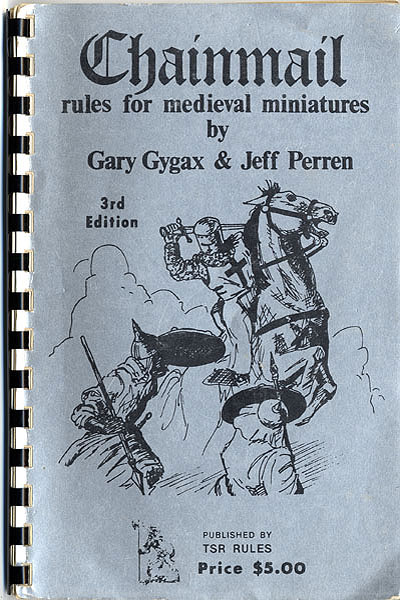
Chainmail
Chainmail by Gary Gygax & Jeff Perren was not a role-playing game. However, Chainmail's second and third editions contained a 50 pages fantasy supplemental setting rules, as well as alternate rules that show similarities to later D&D rules.
Chainmail's Fantasy Supplement introduced many concepts that have endured through all editions of Dungeons & Dragons, including monsters like elementals and the chromatic dragons and spells like fireball, lightning bolt, and polymorph. Magical swords and arrows appear for the first time, as does the concept of dividing creatures by their philosophical alignment to law and chaos. Yet, despite these creative innovations, Chainmail is not a role-playing game, but rather a set of brief rules specifically meant to be used to simulate battles between large numbers of creatures. Brief rules for small battles and sieges suggest the idea of using one miniature to represent a single character (rather than a whole unit), but the rules contain no suggestion that the player assume the role of these figures or establish any element of their "character" beyond the game statistics used to measure their combat effectiveness.
1974 - Dungeons & Dragons Orginal version
 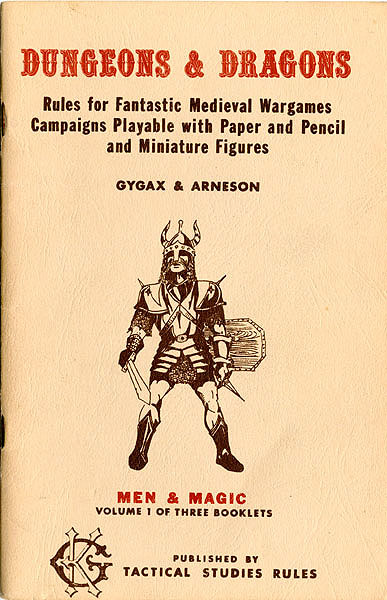 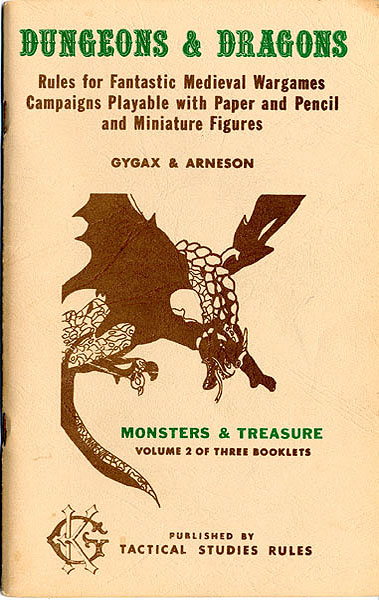 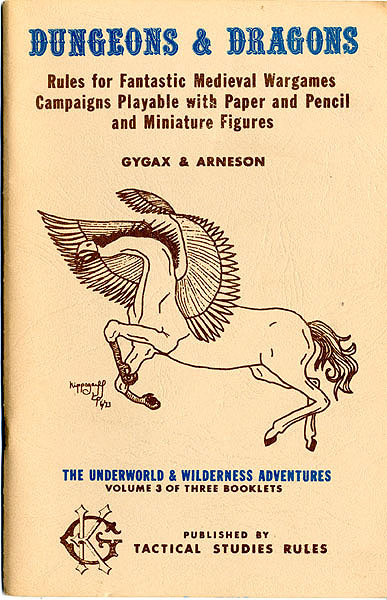
Box set Cover Men and Magic Monsters and Treasures The Underworld
and
Wildernes
Adventures
Three years later, Tactical Studies Rules released a massive expansion of the ideas outlined in Chainmail's Fantasy Supplement in the form of three slim booklets entitled Dungeons & Dragons: Rules for Fantastic Medieval Wargames Campaigns Playable with Paper and Pencil and Miniature Figures.
The title page of the first volume ("Men & Magic") clearly traces D&D's origins back to Chainmail
The original Dungeons & Dragons was published as a boxed set in 1974 and featured only a handful of the elements for which the game is known today: just three character classes (fighting-man, magic-user and cleric); four races (human, dwarf, elf, hobbit); only a few monsters; only three alignments (lawful, neutral, and chaotic).
The rules assumed that players owned and played the miniatures wargame Chainmail and used its measurement and combat systems. An optional combat system was included within the rules that later developed into the sole combat system of later versions of the game. In addition, the rules presumed ownership of Outdoor Survival,
an Avalon Hill board game for outdoor exploration and adventure (an unusual requirement, since Tactical Studies Rules was never in any way affiliated with rival Avalon Hill until two and a half decades later, when Wizards of the Coast - the purchaser of TSR's assets and trademarks - merged with Hasbro, which then owned
Avalon Hill). D&D was a radically new gaming concept at the time, but the rules provided no overview of the game so it was difficult, without prior knowledge of tabletop wargaming, to see how it was all supposed to work.
D&D's three rulebooks covered the spells, equipment, monsters, and combat system necessary to run a campaign centered around exploration of a giant dungeon. Four Player characters gain experience points for defeating monsters in combat and gathering treasure, and in this manner they gain levels, with each level
corresponding to an incremental increase in power and ability.
Characters do not gain experience points for peacefully interacting with the world, but the rules do suggest a world beyond the dungeon, even if they don't spend an enormous amount of time offering suggestions to the DM regarding how to handle its exploration. To get a hireling into service, for example, characters are expected to post notices at inns and taverns, send messengers to distant lands, or frequent public places, but the rules framework provided by the manuals focuses on the financial cost to the character rather than on social interaction.
The most revealing window into the way D&D was meant to be played comes from the fact that the Dungeon Master was called “The Referee” and one player in the group was appointed as “Caller” - a player designated to speak on behalf of the group.
While the idea of a single player monopolizing the referee's time may seem strange from the perspective of a modern gamer, it must have been a necessity for a rules system that suggested an optimal player-to-referee ratio of 20:1. The assumption of such a large group of players came partly from the game's wargaming roots, but also from the enormous popularity of Arnesons and Gygax's campaigns,
each of which consisted of more than a dozen active players at their height.
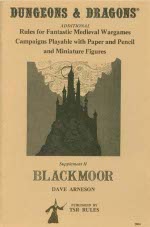 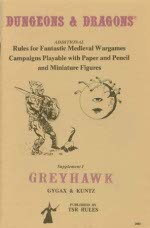 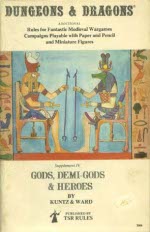 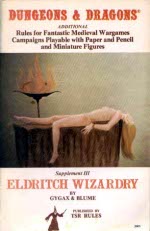
Blackmoor Greyhawk Gods, demi gods and heroes Eldritch Wizardry
The release of the Greyhawk Supplement removed the game's dependency on the Chainmail rules, and made it much easier for new, non-wargaming players to grasp the concepts of play. Ironically, the ambiguities and obscurities of the original rules helped D&D's success as individual groups had to develop their own rulings and
ways of playing and thus gained a sense of ownership of the game. It also inadvertently aided the growth of competing game publishers, since just about anyone who grasped the concepts behind the game could write
smoother and easier to use rules systems and sell them to the growing D&D fanbase(Tunnels & Trolls being the first such).
Supplements such as Greyhawk, Blackmoor, Eldritch Wizardry and Gods, Demi-Gods and Heroes (the last predecessor of Deities and Demigods), published over the next two years, greatly expanded the rules, character classes, monsters and spells.
For example, the original Greyhawk supplement introduced the thief class, and weapon damage varying by weapon (as opposed to character class).
In addition, many changes were "officially" adopted into the game and published in the magazines The Strategic Review and its successor Dragon Magazine.
1977 - Dungeons & Dragons 2nd version
(The branching point between D&d and AD&D)
 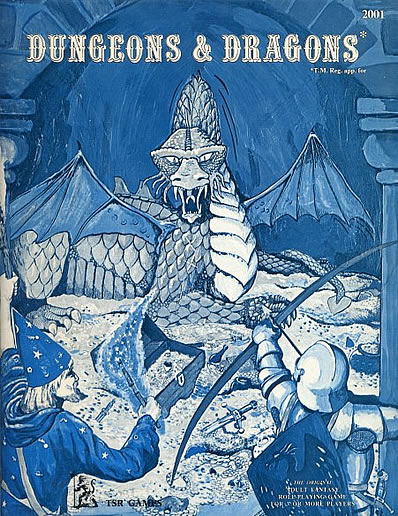
Box set Cover Basic Rules
The Dungeons & Dragons Basic Set, a larger, more visually attractive boxed set that sought to introduce new players to the concept of role-playing by focusing on only the first three levels of play, thereafter directing interested players to the much more expansive Advanced Dungeons & Dragons game, forthcoming from Gary Gygax and TSR. Writer J. Eric Holmes revised the original Gygax and Arneson manuscript to make the rules far more accessible to children of age 12 and above. Unlike the arcane manila booklets of 1974, Holmes's attractive rulebook opens with a compelling description of play:
Each player creates a character or characters who may be dwarves, elves, Halflings or human fighting men, magic-users, pious clerics or wily thieves. The characters are then plunged into an adventure in a series of dungeons, tunnels, secret rooms and caverns run by another player: the referee often called the Dungeon Master.
The dungeons are filled with fearsome monsters, fabulous treasure, and frightful perils. As the players engagein game after game their characters grow in power and ability: the magic users learn more magic spells, the thieves increase in cunning and ability, the fighting men, Halflings, elves and dwarves, fight with more deadlyaccuracy and are harder to kill. Soon the adventurers are daring to go deeper and deeper into the dungeons on each game, battling more terrible monsters, and, of course, recovering bigger and more fabulous treasure! The game is limited only by the inventiveness and imagination of the players, and, if a group is playing together, the characters can move from dungeon to dungeon within the same magical universe if game referees are approximately the same in their handling of play. The introduction carefully contextualizes the original rules and provides the best description to date of what happens in a Dungeons & Dragons game, limiting the focus exclusively to the
dungeon environment. The 1974 edition's rudimentary guidelines for wilderness play are notably absent, along with the rules handling upkeep of baronies and strongholds
(presumably made irrelevant by the game's focus on low-level characters).
The Basic Set's rules for non-player characters parrot those of the original game, adding nothing to an element of gaming that would see great expansion with future editions.
If the Basic Set's innovation lacked breadth, it certainly delivered in depth.
A section entitled "Dungeon Mastering as a Fine Art" suggests using graph paper to map out vast dungeons composed of "interlocking corridors, passages, stairs, closed rooms, secret doors, traps, and surprises for the unwary". A cutaway illustration depicts a seven-level dungeon built into a mountain carved into a giant stone skull.
The rulebook also includes a brief sample dungeon (complete with a full-page map), and starting with the fourth printing in 1978, the boxed set replaced two booklets of maps, encounter tables, and treasure lists with In Search of the Unknown, a 32-page adventure "module" describing a dangerous cavern complex of empty rooms meant to be stocked by the Dungeon Master using provided random tables. The game might only be about dungeons, but at least the dungeons were getting a lot more interesting, and an element of play-acting first took stage.
1981 - Dungeons & Dragons 3rd version
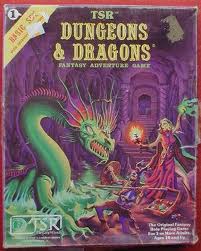   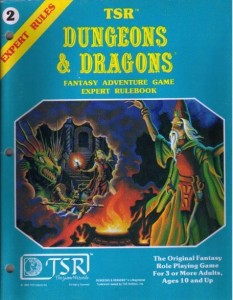
Basic set Box Cover Basic rules lvl 1-3 Expert set Box cover Expert rules lvl 4-14
In 1981, the "basic" version of Dungeons & Dragons was revised by Tom Moldvay and split into several versions.
The Basic and Expert sets are sometimes referred to as "red-box" and "blue-box" D&D.
This version of the basic set included a larger 64-page rule book with a color cover by Erol Otus with a red border, the module B2 The Keep on the Borderlands, 6 polyhedronal dice, and a marking crayon. Cardboard chits were briefly included in place of dice when TSR's source dried up. The cover of the set included the tagline
"Fantasy Adventure Game" under the Dungeons & Dragons logo.
This edition drew solely on the original D&D boxed set for inspiration, rather than including material from its supplements. The game was not brought in line with AD&D but instead was made even more different, and thus the basic Dungeons & Dragons
game became a separate and distinct product from TSR’s flagship game AD&D. This game was promoted as a continuation of the tone of original D&D whereas AD&D was an advancement of the mechanics. Although simpler overall than the ‘Advanced’ game,
it included rules for some situations not covered in AD&D. With the revision of the Basic Set, discrete sets of increasing power levels began to be introduced as expansions for the basic game. The Moldvay Basic Set was immediately followed by the accompanying release of an Expert Set edited by Dave Cook, supporting character levels 4 through 14
1983 - Dungeons & Dragons 4th version
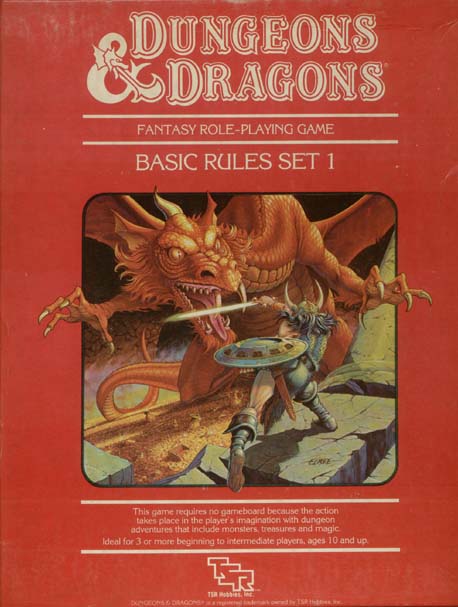  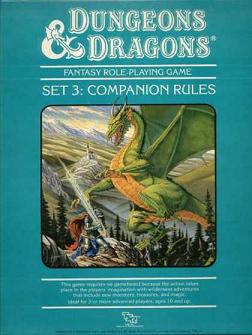
Basic rules lvl 1-3 Expert Rules lvl 4-14 Companion Rules lvl 5-25
 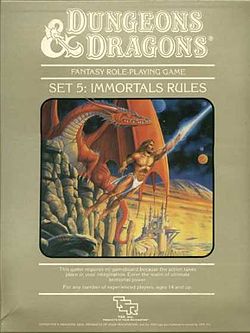
Master Rules lvl 26-36 Immortal Rules lvl 36+
The Basic Set was revised once more in 1983 by Frank Mentzer. Here TSR took a different tack. They split the rule-book up into two parts: a 64-page Players Manual and a 48-page Dungeon Masters Rulebook. Both feature a red dragon on the cover attacking a warrior with a horned helmet swinging a glowing sword.
The Player's Manual contained a six-page choose your own adventure style introduction with you playing a male fighter venturing into caves after Bargle the Infamous. You fight a snake, scoop up treasure, meet a friendly female cleric, fight goblins, and try to resist
Bargle's magic. You can either succeed or fail. Though somewhat limited, this adventure has the classic elements: combat, danger, interaction with others, magic, and treasure. It's still a good introduction to the game in its essence.
There is also another, larger adventure that you can play in the same style later, where it asks you to map as you go along.
Other than this, the manual just presents the various character classes, spells, and miscellaneous items. This is exactly the same rules as the 1981 rule-book.
The Dungeon Master's Rulebook has a sample adventure with boxed text that is ready to run. The first challenge in the adventure is the battle against a the carrion crawler – which has become a legendary fight to remember for many experienced players, who started playing D&D with this set.
After the adventure comes various procedures with explanations for abilities and spells, monsters, treasure, and tips on creating dungeons. The content was mostly the same, but all the introductory and reference material was expanded to more gently introduce people to the game. They also used essentially two artists throughout: Larry Elmore and Jeff Easley, which gives the product a more unified and better presented look. In addition, the production values were a lot higher, so it is much more enjoyable to read.
1991 - Dungeons & Dragons 5th version
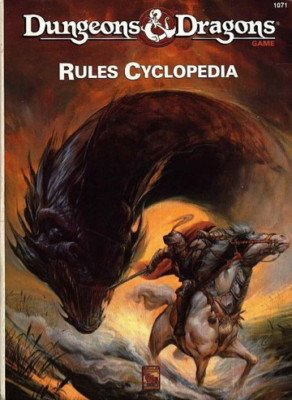 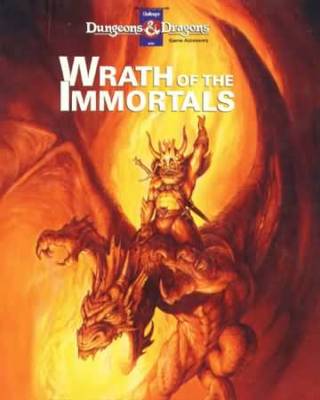
Rules Cyclopedia lvl 1-36 Wrath of Immortals lvl 36+
The D&D Rules Cyclopedia released in 1991 was a 300-page hardback book that collated the vast majority of the Classic D&D rules from the Basic, Expert, Companion and Master rules (and other supplements) into one single tome. Unlike 3rd Edition’s Rules Compendium, the Rules Cyclopedia contained everything you need to play. From complete character generation for all levels of play from 1st to 36th (and beyond)
to monster stat blocks, a complete game world (with colour hex maps) and more, the Rules Cyclopedia has the lot.
Basically, if it’s in D&D, it’s in this book. To get the equivalent content in D&D 3rd Edition (see below) – the three Core Books and several supplements is needed.
It was not only a complete set but the whole content was well structured and hanged well together as a whole.
In the Rules Cyclopedia, the classes contains Fighter, Thief, Magic-User and Cleric – all of whom are Human – and the demi human “classes” of Elf, Dwarf and Halfling like in the older version.
The Rules compendium is by many epxerienced D&D players considered the single best published D&D book ever.
2000 - Dungeons & Dragons 3rd Edition (Technically 6th version)
(Merging with the discontinued Advanced Dungeons & Dragons 2nd edition)
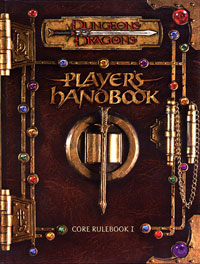 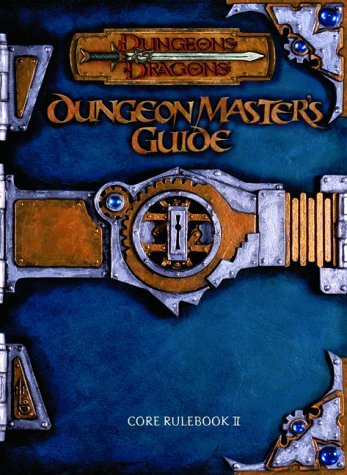 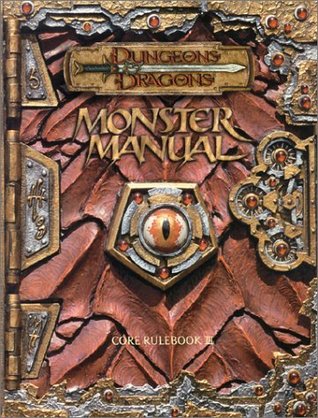
Players Handbook Dungeon Masters guide Monster Manual I
In 2000, Wizards of the Coast (who had purchased TSR two years earlier) decided to reinvent the franchise, and they released a whole new revision of AD&D.
As part of an effort to simplfy the game, they dropped the word "Advanced," and simply called it "Dungeons & Dragons. "They did not see any reason anymore to call it "Advanced" as the "basic" version was dropped and the AD&D series was now effectively
discontinued and merged with the D&D series
This version has informally been referred to by fans and players as a "third" edition of D&D, often abbreviated as "3E D&D."
3E D&D is based on a role-playing system designed around 20-sided dice, called the d20 system. It rationalizes movement and combat (especially ranged combat), removes lots of arbitrary restrictions. Now players can use previously forbidden classes, such as a half-orc monk and incorporates skills and feats to allow players to customize their characters.

The formalisation and release of the d20 system chose Wizards of the Coast to call an "open source" version of the D&D core rules. The idea was that the "open source" rules allowed others to create D&D-compatible content, or entirely different games using this "game engine". The requirement was just that the creator paid a licensing fee to
Wizards of the Coast. Look here for more info: D&D reference document and licensing.
2003 - Dungeons & Dragons Revised 3rd Edition (version 3.5)
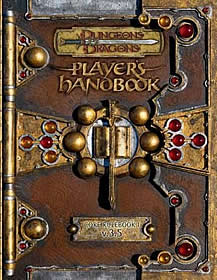 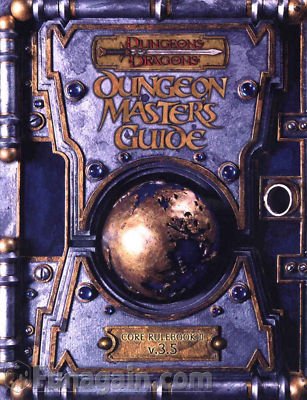 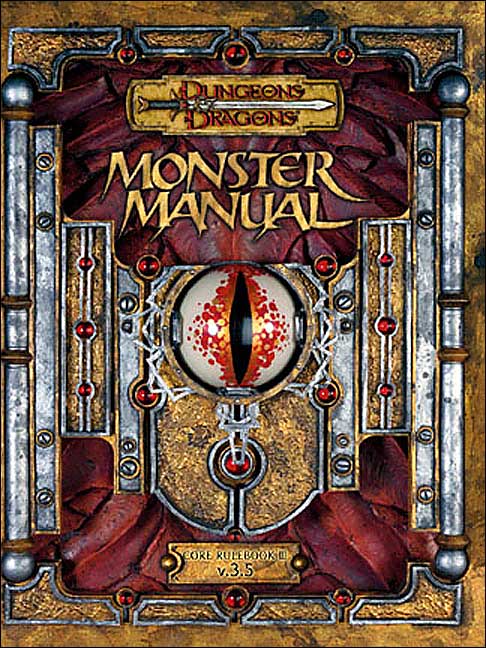
Players Handbook Dungeon Masters guide Monster Manual I
Apart from the revision of the classes and spells and inclusion of erratta published to the 3rd edition no material changes has been included in Players Handbook.
The Ranger class has been updated. Their front-heaviness has been scaled right back, and they get the option of an archery combat style rather than two-weapon fighting. Their tracking abilities have been emphasised, as have their sneakier side.
Animal companions for druids and rangers have been completely reworked – they now only receive one companion who improves in ability like a wizard’s familiar.
Rogues and Barbarians have become slightly better at avoiding traps, and Bards and Sorcerers can lose a spell every time they get a new level of spells in favour of a new one of the same level.
Monks unarmed attacks have also been reworked, making them much more streamlined.
Diagonal movement has been complicated, one little change which makes it slightly harder for those trying to run without miniatures/counters.
A lot of new feats have been added, although most of them are ‘+2 to two skills’.
Ambidexterity has been incorporated into Two-Weapon Fighting, boosting up the prerequisites for the latter but all in all making it a much more feasible choice for non-rangers.
A few new skills have been added, and a couple of old ones have been dropped.
The spell section has undergone a minor revamp. A lot of the old unbalanced spells have been altered and all the stat boost spells give you a straight +4 bonus. All of the lesser and greater spells have been listed underneath their normal counterpart, and mass spells
have been introduced.
The DM guide does not contain any material new content. Mostly, the new material consists of stuff culled from V.3.0 supplements
The new monster manual is significantly improved compared to v.3.0. With new art and a new organization. Templates have been fully integrated with the normal monsters and have great new illustrations. Celestials have been separated into categories
(Angels, Eladrins and Guardinals) and all the pictures are annotated. Most monsters also have a Level Adjustment and all have descriptive text for when your PCs encounter them.
Monsters suitable for use as PCs (Drow, aasimar and teiflings etc.) have full racial stats so you don’t have to work them out from the main block. Spellcasting monsters have typical spell selections. In the back, there’s also a hefty section on advancing
monsters and creating new ones.
2008, 2009, 2010 - Dungeons & Dragons 4th Edition
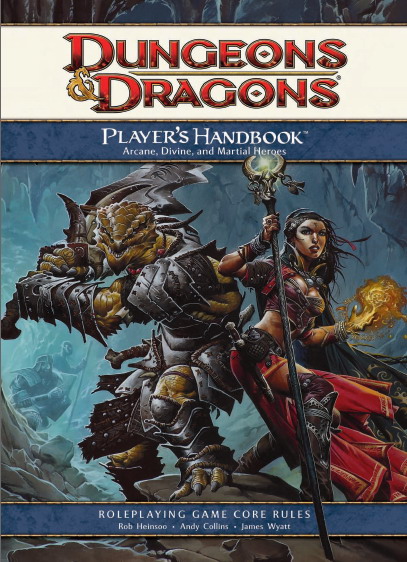 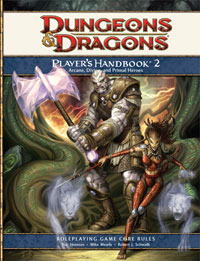 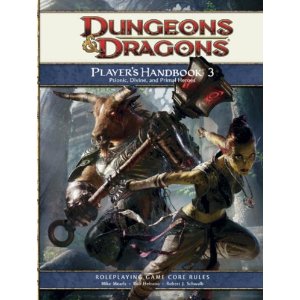
Players Handbook 1 Players Handbook 2 Players Handbook 3
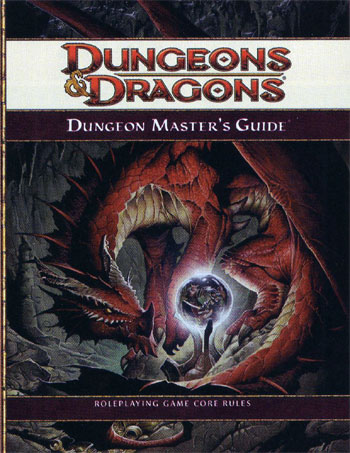 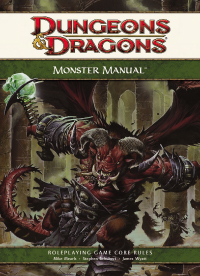
Dungeon Masters Guide Monster Manual I
D&D 4th edition is the radical replacement for the previous version 3 and 3.5.
It is a new game system appealing to easily new players, more combat oriented players, power builders and a lower-hassle game play experience. D&D 4th edition is a major streamline. Though the books are equally thick, in reality the rule density is about a third of 3.5.
The books have bigger type, more air, and more content (items and skills, as opposed to rules). In combat, the pace go around the table faster for each combat round, but for more rounds. There is less to look up, adjudicate, and get finicky about. There is a lot more back-and-forth tides of fortune in each encounter. Hit points go down and up and down more dramatically for the players, so battles just take longer.
The monsters are tougher.
Character building and leveling is a lot faster, trading again simplicity for speed and less rule look ups. It takes approximately 25% of the time to set up a new character and half the time to level one up compared to D&D v.3.5 – again appealing to new players and fast advancing groups.
D&D 4th edition gives significant fewer options in combat, skills, feat and equipment – but due to increased power of the classes and races it is more epic. There is fewer options in character building and there is also no multi classing in 4th edition.
A few examples of the 4th edition is more or less a new game system fully disconnected to D&D 3.5:
- Dwarves don’t have darkvision.
- Diagonal movement has no penalty.
- You start each encounter at nearly full strength.
- There are no skill ranks.
- Intelligence can help your reflex save and AC
- Equipment helps less, so wizards can have quite high AC
- Gnomes are out, and so are half-orcs from the race list
- Dragonborn, Tieflings and Eladrin has been added as playable races.
- Druids, bards, barbarians and sorcerers as classes are gone and they've been replaced with the Warlord and Warlock.
- Powers (combat actions, prayers, spells, etc) are the most important parts of the classes and make up 90% of what you actually do
during combat
- Skills have been streamlined and lumped together. The new skill Thievery for example is an amalgamation of trap disabling, picking locks,
picking pockets, sleight of hand and anything else that involves thievery (including forgery and disguise).
The character build is lot more like a World of Warcraft tree than what is known from previous D&D editions. All characters uses “powers”
in combat which makes every class seem semi-magical and epic.
In addition emphasis has been put on developing strong roles for both monsters and players, making combat a real interplay of
tank/healer/crowd controller/ Damage dealer roles as known from MMORPG
|